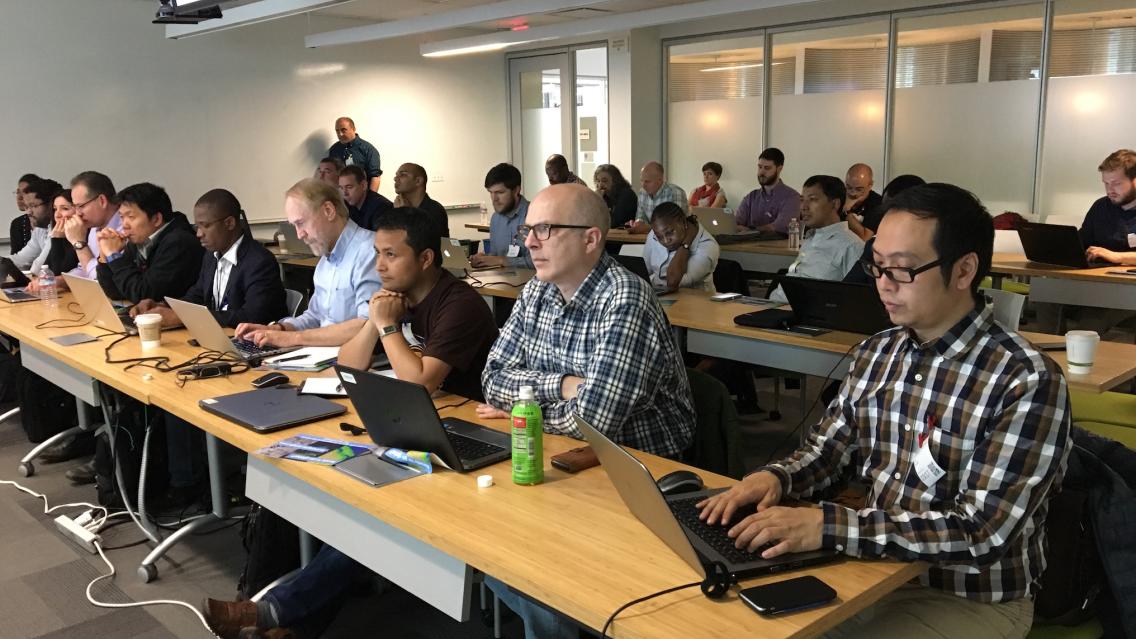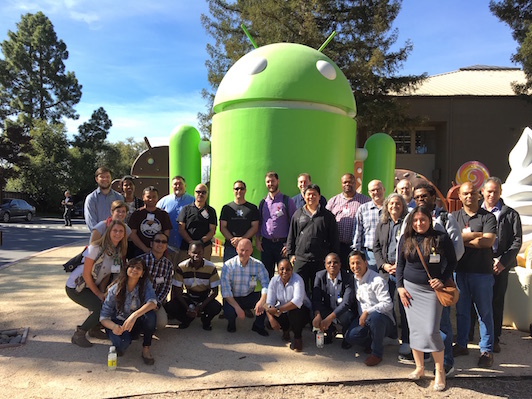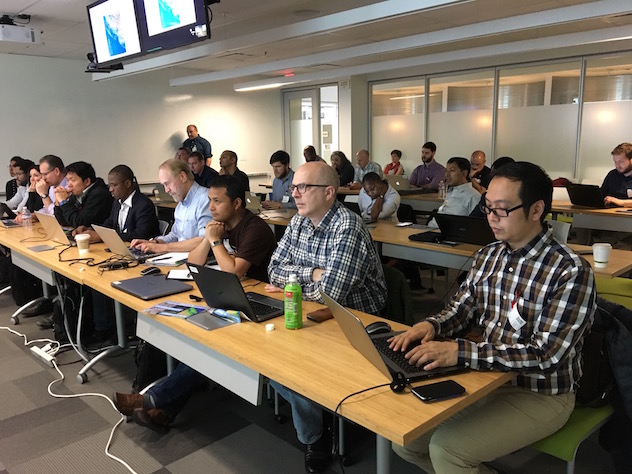SERVIR team members converge for week-long Technology Exchange

The SERVIR Science Coordination Office recently convened a week-long Geospatial Information Technology (GIT) exchange hosted at the University of San Francisco for members of the SERVIR global network. Representatives from SERVIR-West Africa, SERVIR-Eastern & Southern Africa (E&SA), SERVIR-Himalaya, and SERVIR-Mekong made the trip to spend 13-17 March 2017 in the “City by the Bay” with USAID, NASA, and SERVIR Support Team personnel. Experts from leading technology companies in the geospatial information arena also participated during the first two days of the event. The annual exchange is primarily a venue for sharing information and knowledge among the SERVIR network on Geospatial Information Technologies, and to promote collaboration in GIT matters across the network.
 |
| Exchange attendees gather for a group photo opp in Google's Android statue garden |
The week started with featured presentations by Amazon, Digital Globe, Docker, Esri, Google, Hexagon Geospatial, Radiant, and Trimble about their recent innovations, which are extremely valuable for streamlining GIT operations and/or providing value added services. SERVIR partners with such organizations to raise awareness of new technologies, strengthen hub technical expertise, increase access to data, high-resolution imagery, and software, and provide additional training opportunities. These experts made themselves available for face-to-face breakout sessions, interacting directly with SERVIR hub team members for more in-depth and meaningful conversations.
“I attended the exchange to let the SERVIR hubs know how Google technologies can help them achieve their goals, and to learn from the hubs what their goals are to help prioritize implementation of new Google Earth Engine features,” said Nicholas Clinton, from Google. “It was great to see the array of geospatial technologies from which SERVIR builds solutions. I am hopeful that we will soon be able to implement features that will be of benefit to SERVIR and the hubs.”
Noah Ahles from the University of Vermont’s Spatial Analysis Lab, who presented on behalf of the Trimble Innovation Program, noted that “The small number of people really made it much more manageable to digest as much information as possible with many side conversations about the various projects.”
Brett Thomassie from DigitalGlobe commented that the exchange “opened discussion around real problems faced globally and the obstacles faced in solving some of those problems.”
He continued: “In order to solve some of these problems, it’s important that the partners work together…. I believe SERVIR provides a great access point to technology, but the hurdles still lie in training, access, and the combination of multiple solutions to solve problems. In most cases, one technology cannot solve all problems. Partnership is critical.”
In addition to the new technology discussions with the partners, the exchange promoted consultation and communication among the SERVIR hubs on application/data development plans, technological platform management, open source and commercial software strategies, key GIT projects, and opportunities to support one another in their work. Panel discussions were held about challenges facing different hubs and potential solutions for addressing common needs. A major point of discussion centered on the cumulative, near-to-mid-term compute processing and data storage infrastructure needs across the hubs, as well as potential solutions.
 |
| Exchange attendees during a session |
Ngugi Kimani of SERVIR-E&SA said the event helped him “learn about what is the happening in the SERVIR hubs as far as GIT is concerned as well as sharing our experiences and best practices…and addressed the computation challenges the hubs have been experiencing.” He said he acquired knowledge from the other hubs and private companies and that he learned how to use Google Earth Engine.
“I plan to use it to share land cover maps,” he noted.
Anastasia Wahome of SERVIR-E&SA said the event allowed her “to engage with hub counterparts, share and learn more from them, and learn about new products and technologies from hub participants and invited vendors.” She commented that she learned of new products and platforms such as Tethys (through a related NASA Applied Sciences Team project at BYU), Docker, and the edX online learning platform, and now has plans to explore them further for possible SERVIR-E&SA use. She also noted that discussions of hub infrastructure were timely.
“Sharing of knowledge between hubs and looking more in-depth at hub capacities (computing and infrastructure) gave a better insight into how hubs look at issues in this area given the different geographic locations.”
Hari Krishna Dhonju of SERVIR-Himalaya called the exchange “an exciting and encouraging event which helped us to extend our global family.”
Notes:
SERVIR-West Africa is located at the Agrometeorology, Hydrology and Meteorology (AGRHYMET) Regional Center in Niamey, Niger. SERVIR-Eastern & Southern Africa is located at the Regional Centre for Mapping of Resources for Development (RCMRD) in Nairobi, Kenya. SERVIR-Himalaya is located at the International Centre for Integrated Mountain Development (ICIMOD) based in Kathmandu, Nepal. SERVIR-Mekong is located at the Asian Disaster Preparedness Center (ADPC) in Bangkok, Thailand.

